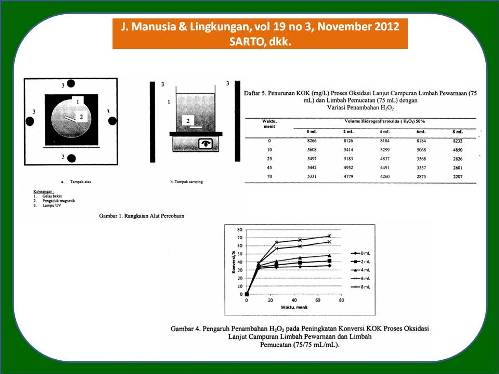
POTENSI PEMANFAATAN AIR LIMBAH PEMUCAT INDUSTRI TENUN ATBM UNTUK MENURUNKAN KEBUTUHAN OKSIGEN KIMIAWI (KOK) AIR LIMBAH PEWARNAAN (The Potency of Using Bleaching Wastewater to reduce Chemical Oxygen Demand (COD) in Dyeing Wastewater of Traditional Weaving)
Sarto Sarto(1*), I Made Bendiyasa(2), Yustina Rusnawati(3)
(1) Jurusan Teknik Kimia FT UGM
(2) Jurusan Teknik Kimia FT UGM
(3) Jurusan Teknik Kimia FT UGM
(*) Corresponding Author
Abstract
ABSTRAK
Kegiatan tenun ATBM di Gamplong menghasilkan air limbah terutama dari proses pewarnaan dan proses pemucatan. Bahan pewarna merupakan senyawa komplek dan relatif stabil sehingga sulit ditangani. Proses oksidasi lanjut telah terbukti mampu menurunkan kadar bahan pewarna dalam air limbah. Penelitian ini mempelajari potensi air limbah pemucatan untuk menurunkan kadar bahan pewama dalam air limbah pewarnaan. Proses pencampuran air limbah pewarna dengan air limbah pemucatan dilakukan di dalam sebuah reaktor batch yang dilengkapi empat lampu UV masing-masing 10 Watt dan sebuah pengaduk magnit. Penurunan kadar zat warna dinyatakan dalam Kebutuhan Oksigen Kimiawi (KOK). Setiap jangka (interval) waktu tertentu, cuplikan air limbah sebanyak 2 mL diambil dari reaktor lalu dianalisis KOK nya. Rasio volume limbah pewarnaan terhadap limbah pemucatan adalah 3:1, 2:1, 1:1, 1:2, dan 1:3. Hasil penelitian menunjukkan bahwa semakin kecil nisbah limbah pewamaan dengan limbah pemucatan menghasilkan penurunan KOK semakin besar. Dengan volume limbah total 150 m, potensi oksidasi limbah pemucatan setara dengan sekitar 2 mL hidrogen peroksida 50% dalam 150 mL air limbah.
ABSTRACT
Traditional weaving activities in Gamplong produce wastewater, mainly from dyeing and bleaching processes. Dyes are complex compounds and realtively stable which is difficult to be managed. Advanced oxidation processes have proved to be able to decrease dyes content in the wastewater. The aim of this experiment is to study the potency of bleaching wastewater to reduce dyes content in dyeing wastewater. The mixing process of those wastewater was conducted in a batch reactor which was equipped with 4 UV light of 10 W each and a magnetic stirrer. The mixing process was performed at ambient temperature and pressure. Dyes content in the wastewater was expressed in chemical oxygen demand (COD). Each run, total volume of wastewater of dyeing process or mixtures of dyeing process and bleaching process were 150 mL. At a certain time interval, 2 mL of treated wastewater was sucked up from the reactor, and then its COD content was analysed. The volume ratios of dyeing wastewater to bleaching wastewater investigated were 3:1, 2:1, 1:1, 1:2, and 1:3. The experiment results showed that the COD conversion increases with the decreases of the ratio of dyeing wastewater to bleaching wastewater. The more H2O2 addition to the dyeing wastewater, the more COD reduction is. For the ratio of dyeing wastewater to belaching wastewater 1:1, the higher the H2O2 50% addition, the higher the reduction of COD is.
Keywords
Full Text:
Artikel lengkap (PDF) (Bahasa Indonesia)Article Metrics
Refbacks
- There are currently no refbacks.
Copyright (c) 2017 Jurnal Manusia dan Lingkungan







